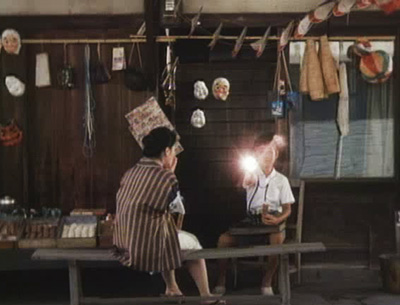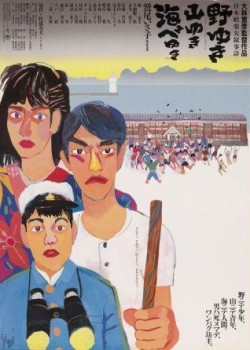BOUND FOR THE FIELDS, THE MOUNTAINS, AND THE SEACOAST (NO YUKI YAMA YUKI UMIBE YUKI) (Nobuhiko Obayashi, 1986)
Japan Society
333 East 47th St. at First Ave.
Saturday, November 21, $12, 4:00
Series continues through December 6
212-715-1258
www.japansociety.org
 Over the opening credits of Nobuhiko Obayashi’s Bound for the Fields, the Mountains, and the Seacoast, the sweet sound of children singing can be heard over machine-gun blasts and explosions, immediately setting the tone for this unusual, highly stylized war-set drama. “It was a time of mischief in Japan. Even in wartime,” it says at the end of the black-and-white credits, before cutting to a shot of the red-and-white Japanese flag blowing in the wind. Kids slowly march to school to the beating of a drum, except for Sotaro Sudo (Yasufumi Hayashi), who skips down narrow streets by himself, wearing a pseudo-military outfit and carrying a pair of binoculars to help him spy on what’s going on. When he spots someone in the teacher’s (Jô Shishido) office who he’s never seen before, he wonders to himself, “She looks too young to be an adult, but too old to be a child.” That sets the stage for the rest of the film, in which Obayashi follows a group of boys and girls as they battle among themselves, experience bullying and budding sexuality, and grow up a little too fast, serving as a microcosm of twentieth-century Japan. “It is clear that reality and lies can divide people. We should not quarrel too hastily,” the teacher says. Sotaru becomes enamored with the young woman, Kawakita (Riki Takeuchi), whose younger brother, Sakae Osugi (Junichirô Katagiri), is new in school. “Please don’t be violent,” Kawakita tells Sakae, but it isn’t long before he may not have any other choice, especially when their parents (Taru Minegishi and Toshie Negishi) consider selling her into prostitution to pay off their mounting debts.
Over the opening credits of Nobuhiko Obayashi’s Bound for the Fields, the Mountains, and the Seacoast, the sweet sound of children singing can be heard over machine-gun blasts and explosions, immediately setting the tone for this unusual, highly stylized war-set drama. “It was a time of mischief in Japan. Even in wartime,” it says at the end of the black-and-white credits, before cutting to a shot of the red-and-white Japanese flag blowing in the wind. Kids slowly march to school to the beating of a drum, except for Sotaro Sudo (Yasufumi Hayashi), who skips down narrow streets by himself, wearing a pseudo-military outfit and carrying a pair of binoculars to help him spy on what’s going on. When he spots someone in the teacher’s (Jô Shishido) office who he’s never seen before, he wonders to himself, “She looks too young to be an adult, but too old to be a child.” That sets the stage for the rest of the film, in which Obayashi follows a group of boys and girls as they battle among themselves, experience bullying and budding sexuality, and grow up a little too fast, serving as a microcosm of twentieth-century Japan. “It is clear that reality and lies can divide people. We should not quarrel too hastily,” the teacher says. Sotaru becomes enamored with the young woman, Kawakita (Riki Takeuchi), whose younger brother, Sakae Osugi (Junichirô Katagiri), is new in school. “Please don’t be violent,” Kawakita tells Sakae, but it isn’t long before he may not have any other choice, especially when their parents (Taru Minegishi and Toshie Negishi) consider selling her into prostitution to pay off their mounting debts.
Bound for the Fields, the Mountains, and the Seacoast is a fanciful fairy tale that has fun playing with Japanese storytelling conventions, mixing genres while utilizing over-the-top comic-book surrealism. Obayashi, who gained international fame for his cult hit House, instills this unique coming-of-age story with scenes that not only evoke cartoony manga panels but also the films of Yasujiro Ozu, Kenji Mizoguchi, and Shuji Terayama. Not one for subtlety, he intercuts several drawings of animals from an odd kind of textbook that Sotaru carries with him, making humorously metaphorical comparisons between humans and beasts. Though often silly and patently absurd, Bound for the Fields, the Mountains, and the Seacoast has an infectious, irresistible charm that will pull you right in even as you contemplate how ridiculous so much of it is. The film, adapted by screenwriter Nobuo Yamada from Haruo Satô’s novel A Time of Mischief, was made into black-and-white and color versions; the former no longer exists, but the latter is having a rare screening November 21 at 4:00 in the Japan Society series “Nobuhiko Obayashi: A Retrospective,” which continues through December 6 with such other Obayashi films as I Are You, You Am Me; Sada; The Discarnates; and his latest, the three-hour epic Seven Weeks, in addition to a special conversation and audience Q&A with Obayashi, moderated by series curator Aaron Gerow, on November 21 at 1:00 ($12).

